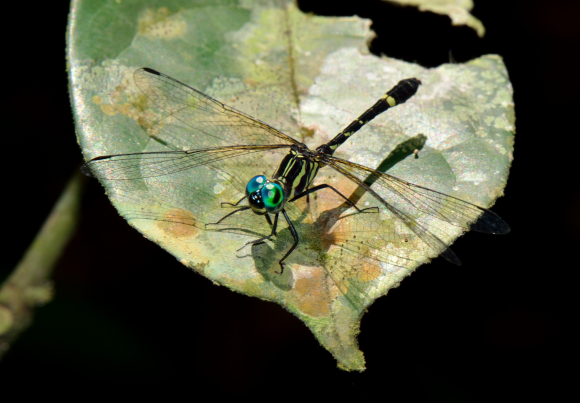Genus Tetrathemis Brauer, 1868
elfs
Synonyms:
- scientific: Neophlebia Selys, 1869 [polleni]
Type species: Tetrathemis irregularis Brauer, 1868
Introduction
The genus ranges from tropical Africa, across southern Asia to Australia. Half of about sixteen species are African: they are quite distinct and may well belong to a separate genus, Neophlebia. Seven species are nearly identical, small (hindwing 20-25 mm) and black marked with yellow or green, preferring rainforest pools and swamps, differing mainly in their appendages. T. polleni, however, is larger (hindwing 22-30 mm) and mature males have entirely grey pruinose bodies and largely dark wings. They like shady pools in savanna, woodland and forest edge, like muddy watering holes and puddles in drying streambeds. Males of all species perch conspicuously at suitable pools, flying into the trees when disturbed. Females lay their eggs while settled on plants or sticks (or similar substrates) above the water surface. [Adapted from Dijkstra & Clausnitzer 2014]
Diagnosis
Male of genus is similar to Notiothemis by (a) size, Hw 20-31 mm; (b) Fw discoidal field of 1 cell-row at base; (c) Fw supratriangle with 1-2 cross-veins, only rarely none; (d) Fw triangle and subtriangle usually of 1 cell, rarely both 2; (e) Fw discoidal field of 1-2 rows at base; (f) always 1 cell-row in radial planate; (g) bridge spaces with 1 crossvein, only rarely 2; (h) 7-11 Ax in Fw; (i) 2-4 Cux in Hw; (j) anterior denticles on hind femora wide distally, square-cut or directed towards base; (k) hamule without longitudinal ridge, with hook bent outwards, well visible in lateral view; (l) S7 with conspicuous pale mark, which is more prominent than any marking on S6 (invisible when covered by pruinosity). However, differs by (1) dorsum of frons shiny black rather than pale; (2) Fw discoidal field of 1 row to beyond node; (3) Fw triangle appears quadrangular rather than three-sided; (4) vein separating Fw cubital space and subtriangle in line with cross-vein in supratriangle; (5) always 2 rather than from 2 to 4 Cux in Hw. [Adapted from Dijkstra & Clausnitzer 2014]

Tetrathemis fraseri Legrand, 1977. © Nicolas Meziere

Tetrathemis godiardi Lacroix, 1921. © KD Dijkstra
Map citation: Clausnitzer, V., K.-D.B. Dijkstra, R. Koch, J.-P. Boudot, W.R.T. Darwall, J. Kipping, B. Samraoui, M.J. Samways, J.P. Simaika & F. Suhling, 2012. Focus on African Freshwaters: hotspots of dragonfly diversity and conservation concern. Frontiers in Ecology and the Environment 10: 129-134.
References
- Dijkstra, K.-D.B. (2007). The name-bearing types of Odonata held in the Natural History Museum of Zimbabwe, with systematic notes on Afrotropical taxa. Part 1: introduction and Anisoptera. International Journal of Odonatology, 10, 137-170. [PDF file]
- Longfield, C. (1936). Studies on African Odonata, with synonymy and descriptions of new species and subspecies. Transactions Royal Entomological Society London, 85, 467-498. [PDF file]
- Pinhey, E.C.G. (1962). Some records of Odonata collected in tropical Africa. Journal Entomological Society Southern Africa, 25, 20-50. [PDF file]
- Fraser, F.C. (1954). Further notes and descriptions of new species of Libellulidae from tropical Africa. Revue Zoologie Botanique Africaines, 50, 252-268. [PDF file]
Citation: Dijkstra, K.-D.B (editor). African Dragonflies and Damselflies Online. http://addo.adu.org.za/ [2024-10-30].

